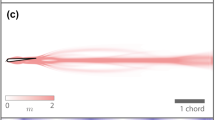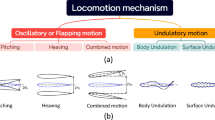Abstract
Feedback flow information is of significance to enable underwater locomotion controllers with higher adaptability and efficiency within varying environments. Inspired from fish sensing their external flow via near-body pressure, a computational scheme is proposed and developed in this paper. In conjunction with the scheme, Computational Fluid Dynamics (CFD) is employed to study the bio-inspired fish swimming hydrodynamics. The spatial distribution and temporal variation of the near-body pressure of fish are studied over the whole computational domain. Furthermore, a filtering algorithm is designed and implemented to fuse near-body pressure of one or multiple points for the estimation on the external flow. The simulation results demonstrate that the proposed computational scheme and its corresponding algorithm are both effective to predict the inlet flow velocity by using near-body pressure at distributed spatial points.
Similar content being viewed by others
References
Fish F E, Lauder G V. Passive and active flow control by swimming fishes and mammals. Annual Review of Fluid Mechanics, 2006, 38, 193–224.
Wen L, Waver J, Lauder G V. Biomimetic shark skin: Design, fabrication and hydrodynamic testing. The Journal of Experimental Biology, 2014, 217, 1637–1638.
Liao J C. A review of fish swimming mechanics and behaviour in altered flows. Philosophical Transactions of the Royal Society B, 2007, 362, 1973–1993.
Voigt R, Carton A G, Montgomery J C. Responses of anterior lateral line afferent neurones to water flow. The Journal of Experimental Biology, 2000, 203, 2495–2502.
Przybilla A, Kunze S, Rudert A, Bleckmann H, Brücker C. Entraining in trout: A behavioural and hydrodynamic analysis. The Journal of Experimental Biology, 2010, 213, 2976–2986.
Coombs S, Bleckmann H, Fay R R. The Lateral Line System, Springer, New York, 2014.
Webb J F. Gross morphology and evolution of the mechanosensory lateral line system in teleost fishes. Brain, Behavior and Evolution, 1989, 33, 34–53.
Liu J D, Hu H. Biologically inspired behaviour design for autonomous robotic fish. International Journal of Automation and Computing, 2006, 3, 336–347.
Triantafyllou M S, Triantafyllou G S. An efficient swimming machine. Scientific American, 1995, 272, 62–70.
Wen L, Wang T M, Wu G H. Hydrodynamic investigation of a self-propulsive robotic fish based on a force-feedback control method. Bioinspiration & Biomimetics, 2012, 7, 036012.
Kato N. Median and paired fin controllers for biomimetic marine vehicles. Applied Mechanics Reviews, 2005, 58, 238–252.
Hu T J, Shen L C, Lin L X. Biological inspirations, kinematics modeling, mechanism design and experiments on an undulating robotic fin inspired by Gymnarchus Niloticus. Mechanism and Machine Theory, 2009, 44, 633–645.
Zhou C L, Low K H, Chong C W. An analytical approach for better swimming efficiency of slender fish robots based on Lighthill’s model. IEEE International Conference on Robotics and Biomimetics, Guilin, China, 2009, 1651–1656.
Low K H, Chong C W. Parametric study of the swimming performance of a fish robot propelled by a flexible caudal fin. Bioinspiration & Biomimetics, 2010, 5, 046002.
Wen L, Wang T M, Wu G H, Liang J H. Hydrodynamic performance of an undulatory robot: Functional roles of the body and caudal fin locomotion. International Journal of Advanced Robotic System, 2013, 9, 1–10.
Dusek J, Kottapalli A G P, Woo M E, Asadnia M, Miao J, Lang J H, Triantafyllou M S. Development and testing of bio-inspired microelectromechanical pressure sensor arrays for increased situational awareness for marine vehicles. Smart Materials and Structures, 2013, 22, 014002.
Yang Y C, Chen J, Engel J, Pandya S, Chen N, Tucker C, Coombs S, Jones D L, Liu C. Distant touch hydrodynamic imaging with an artificial lateral line. Proceedings of the National Academy of Sciences of the United States of America (PNAS), 2006, 103, 18891–18895.
Abdulsadda A T, Tan X B. Nonlinear estimation-based dipole source localization for artificial lateral line systems. Bioinspiration & Biomimetics, 2012, 8, 026005.
Fernandez V I, Maertens A, Yaul F M, Dahl J, Lang J H, Triantafyllou M S. Lateral-line-inspired sensor arrays for navigation and object identification. Marine Technology Society Journal, 2011, 45, 130–146.
Bouffanais R, Weymouth G D, Yue D K P. Hydrodynamic object recognition using pressure sensing. Proceedings of the Royal Society A, 2010, 467, 19–38.
Venturelli R, Akanyeti O, Visentin F, Ježov J, Chambers L D, Toming G, Brown J, Kruusmaa M, Megill W M, Fiorini P. Hydrodynamic pressure sensing with an artificial lateral line in steady and unsteady flows. Bioinspiration & Biomimetics, 2012, 7, 036004.
Chambers L D, Akanyeti O, Venturelli R, Ježov J, Brown J, Kruusmaa M, Fiorini P, Megill W M. A fish perspective: detecting flow features while moving using an artificial lateral line in steady and unsteady flow. Journal of the Royal Society Interface, 2014, 11, 20140467.
DeVries L, Paley D A. Observability-based optimization for flow sensing and control of an underwater vehicle in a uniform flowfield. American Control Conference, Washington D. C., USA, 2013, 1386–1391.
Lagor F D, DeVries L D, Waychoff K M, Paley D A. Bio-inspired flow sensing and control for autonomous underwater navigation using distributed pressure measurements. Proceedings of 18th International Symposium on Unmanned Untethered Submersible Technology, Portsmouth, New Hampshire, 2013.
Salumäe T, Kruusmaa M. Flow-relative control of an underwater robot. Proceedings of the Royal Society, 2013, 469, 20120671.
Ježov J, Akanyeti O, Chambers L D, Kruusmaa M. Sensing oscillations in unsteady flow for better robotic swimming efficiency. Proceedings of IEEE International Conference on Systems, Man and Cybernetics, Seoul, Korea, 2012, 91–96.
Ayali A, Gelman S, Tytell E D, Cohen A H. Lateral-line activity during undulatory body motions suggests a feedback link in closed-loop control of sea lamprey swimming. Canadian Journal of Zoology, 2009, 87, 671–683.
Akanyeti O, Chambers L D, Ježov J, Brown J, Kruusmaa M, Megill W M, Fiorini P. Self-motion effects on hydrodynamic pressure sensing: Part I. forward-backward motion. Bioinspiration & Biomimetics, 2013, 8, 026001.
Liu H, Wassersug R J, Kawachi E. A computational fluid dynamics study of tadpole swimming. The Journal of Experimental Biology, 1996, 199, 1245–1260.
Carling J, Williams T L, Bowtell G. Self-propelled anguilliform swimming: Simultaneous solution of the two-dimensional navier-stokes equations and newton’s laws of motion. The Journal of Experimental Biology, 1998, 201, 3143–3166.
Wolfgang M J, Anderson J M, Grosenbaugh M A, Yue D K, Triantafyllou M S. Near-body flow dynamics in swimming fish. The Journal of Experimental Biology, 1999, 202, 2303–2327.
Borazjani I, Sotiropoulos F. Numerical investigation of the hydrodynamics of carangiform swimming in the transitional and inertial flow regimes. The Journal of Experimental Biology, 2008, 211, 1541–1558.
Shirgaonkar A A, MacIver M A, Patankar N A. A new mathematical formulation and fast algorithm for fully resolved simulation of self-propulsion. Journal of Computational Physics, 2009, 228, 2366–2390.
Bergmann M, Iollo A. Modeling and simulation of fish-like swimming. Journal of Computational Physics, 2011, 230, 329–348.
Wen L, Wang T M, Wu G H, Liang J H. Quantitative thrust efficiency of a self-propulsive robotic fish: Experimental method and hydrodynamic investigation. IEEE/ASME Transactions on Mechatronics, 2013, 18, 1027–1038.
Rapo M A, Jiang H S, Grosenbaugh M A, Coombs S. Using computational fluid dynamics to calculate the stimulus to the lateral line of a fish in still water. The Journal of Experimental Biology, 2009, 212, 1494–1505.
Windsor S P, Norris S E, Cameron S M, Mallinson G D, Montgomery J C. The flow fields involved in hydrodynamic imaging by blind Mexican cave fish (Astyanax fasciatus). Part I: Open water and heading towards a wall. The Journal of Experimental Biology, 2010, 213, 3819–3831.
Windsor S P, Norris S E, Cameron S M, Mallinson G D, Montgomery J C. The flow fields involved in hydrodynamic imaging by blind Mexican cave fish (Astyanax fasciatus). Part II: Gliding parallel to a wall. The Journal of Experimental Biology, 2010, 213, 3832–3842.
Barbier C, Humphrey J A. Drag force acting on a neuromast in the fish lateral line trunk canal. I. Numerical modelling of external-internal flow coupling. Journal of the Royal Society Interface, 2009, 6, 627–640.
Cheng J Y, Zhuang L X, Tong B G. Analysis of swimming three-dimensional waving plates. Journal of Fluid Mechanics, 1991, 232, 341–355.
Zhou H, Hu T J, **e H B, Zhang D B, Shen L C. Computational and Experimental study on dynamic behavior of underwater robots propelled by bionic undulating fins. Science China Technological Sciences, 2010, 53, 2966–2971.
Hu T J, Low K H, Shen L C, Xu X. Effective phase tracking for bioinspired undulations of robotic fish models: A learning control approach. IEEE/ASME Transactions on Mechatronics, 2014, 19, 191–200.
Zhou H, Hu T J, Wang G M, Zhang D B, Lv Y X. Simulation platform for fishlike swimming. Applied Mechanics and Materials, 2014, 461, 451–458.
Dubois A, Cavagna G A, Fox R S. Pressure distribution on the body surface of swimming fish. The Journal of Experimental Biology, 1974, 60, 581–591.
Author information
Authors and Affiliations
Corresponding author
Rights and permissions
About this article
Cite this article
Zhou, H., Hu, T., Low, K.H. et al. Bio-inspired flow sensing and prediction for fish-like undulating locomotion: A CFD-aided approach. J Bionic Eng 12, 406–417 (2015). https://doi.org/10.1016/S1672-6529(14)60132-3
Published:
Issue Date:
DOI: https://doi.org/10.1016/S1672-6529(14)60132-3




